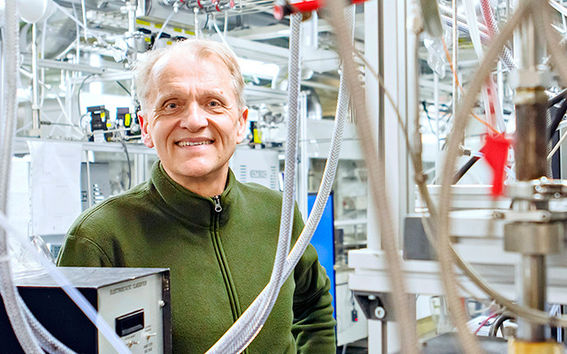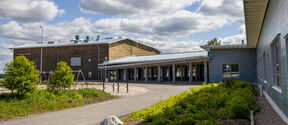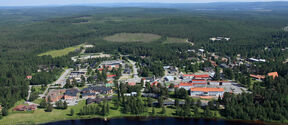At the brink of the new

In 2006, word of the discovery of a new carbon composite nanomaterial by a team or researchers headed by Professor Esko Kauppinen at the Helsinki University of Technology started spreading around the world. The discovery was given the name NanoBud.
NanoBuds are formed by binding spheroidal carbon molecules, fullerenes, to the outer sidewalls of single-walled carbon nanotubes. NanoBuds were revealed for the first time in the journal Nature Nanotechnology in 2007 and the discovery has been granted a new material patent, a very rare occurrence in the modern world.
“We found that NanoBuds are a different material from the carbon nanotubes and fullerenes that had been patented earlier. There was thus no obstacle to patenting,” Kauppinen says.
The research team made NanoBuds through a synthesis gas reactor process that Kauppinen has been researching and developing since the early 1990s.
NanoBuds can be used to manufacture conductive, flexible and bendable thin films. Printed on a thin film of plastic, they can be used in, for example, the touch screens of mobile phones, tablets, cameras and wearable devices.
“In addition to flexibility, a significant advantage of NanoBud films is that they do not reflect light. Their conductivity is about equal to existing metal-oxide films.”
Commercial path
Kauppinen and his researcher colleagues established a spin-off company called Canatu Oy to develop and exploit commercial innovations. A key member of the research team took the helm of this enterprise and Kauppinen still serves on the firm's Board of Directors.
Nowadays, the company has manufacturing premises in the Konala district of Helsinki and employs about 30 people. Its products are marketed actively all over the world.
Canatu manufactures flexible and bendable carbon-based films for touch screens and sensors. There is a wealth of other potential applications, too, but the company has decided to focus on a clearly defined business area.
“Canatu has been able to constantly develop the properties and manufacturing process of its touch sensor. The product is now better than a traditional metal-oxide film and the development work continues.”
A lot remains to be done in basic research. For example, researchers still don't understand how carbon nanotubes and NanoBuds grow atomically.
“At first, it was very difficult to produce nanotubes and NanoBuds. We've come a long way since those days, but we are still studying how to make the synthesis process easier to control and manage. From time to time, we return to old questions to examine and develop them further in light of recent findings.”
Plenty of challenges
Kauppinen has been developing Canatu's operations on top of his academic research work. This has called for long days and a lot of travel.
Fundraising has been a major challenge since the beginning, but Canatu has been helped by the patent granted to its material, its demonstrated competence and frequent publication of scientific papers.
“Project funding from the Academy of Finland has enabled long-term basic research, while the business side has been supported by national agencies like Sitra and Tekes, EU funding organisations and private investors. It would not have been possible to launch business activities without private money.”
Finding customers is another big challenge. It is difficult to convince major, world-class corporations to switch a material they use to something entirely new, even if the new one is better than the old.
It takes a long time to bring an invention from the laboratory to the store shelf. Introducing traditional semiconductors into information technology applications, for example, took about thirty years.
“In basic research, it is enough that researchers can demonstrate that they have, for example, managed to experimentally create specific material properties. On the commercial side, however, other issues like customers, industrial manufacturability, material stability, quality control and price start crowding the picture.”
Cooperation without borders
The creation of NanoBuds called for ten years of intensive research work from Kauppinen and his colleagues. A smattering of good luck was also required, as the main focus was originally on carbon nanotubes and manufacturing them in a synthesis gas reactor. NanoBuds were first observed when conditions in the reactor were changed to study the growth mechanisms of carbon nanotubes.
The present situation is the result of a long-term determined effort. Kauppinen chose the direction of his research long before the NanoBud discovery when he was researching the gas-phase manufacture of nanomaterials. He set his sights on electronics applications because materials technology plays a big part in their development and the materials involved are often expensive.
Kauppinen stresses the importance of a good research team and international cooperation. In addition to Kauppinen, the core group of the team that discovered NanoBuds included colleagues from the USA, Russia and China. Over the years, some thirty people, many of them foreigners, have participated in the research.
“One research group can't do it all. Right now, we are partnering with a Japanese, Chinese, Danish and a French group. Cooperation with the University's own research groups is also important. We learn from one another and cooperation yields us much better results than what we could accomplish by ourselves,” Kauppinen says.
Instructions for innovators
- Innovations are created in groups with a good atmosphere and enthusiasm for new things. In addition to basic research, also consider applications – they go hand in hand!
- Competence resides in the individual. Encourage a fellow researcher, at least one, to join your company when you start commercialising an innovation.
- Be prepared to do extra work on top of your academic duties when establishing a company. This phase can last a long time.
- Prepare to encounter problems of a different kind from the world of research. Be open to new things.
- Be curious and don't be afraid to fail. Things rarely go to plan.
Esko I. Kauppinen received his doctorate from the University of Helsinki's Department of Physics in 1992.
He was in charge of the VTT Technical Research Centre of Finland aerosol technology group in 1992–2001. The group moved to the Helsinki University of Technology (now part of Aalto University) in 2002. Kauppinen was appointed Professor of Physics in 2005. He heads the NanoMaterials Group at the Department of Applied Physics, running one of the world's leading gas-phase synthesis laboratories for NanoBuds, nanotubes and nanomaterials.
Kauppinen has published some 340 scientific articles, almost half of which deal with carbon nanomaterials. He holds 20 patents.
Kauppinen coordinates the IRENA project, a joint venture of European and Japanese research institutions that aims to develop carbon nanotube-based films to replace critical metals like indium and gallium in screen electronics.
Text: Timo Hämäläinen
Photo: Kira Leskinen
The original article is published in the Aalto University Magazine issue 16.
Read more news
Changes to education information in ACRIS
We are updating how education information is managed in Aalto University's research information system, ACRIS. The old source data for education information will be removed to help eliminate potential duplicate entries.
Lecturer Marja Rastas: “As a teacher, you never finish learning”
During her career, the lecturer in art education has witnessed changes in both the field of art education and in education itself.
Study: Wood is a more cost-effective building material than concrete when emissions are monetized
The costs of the wood-built school and sports hall in Myrskylä were compared to a reinforced concrete alternative — and wood proved clearly more economical when environmental impacts were assigned a monetary value.






